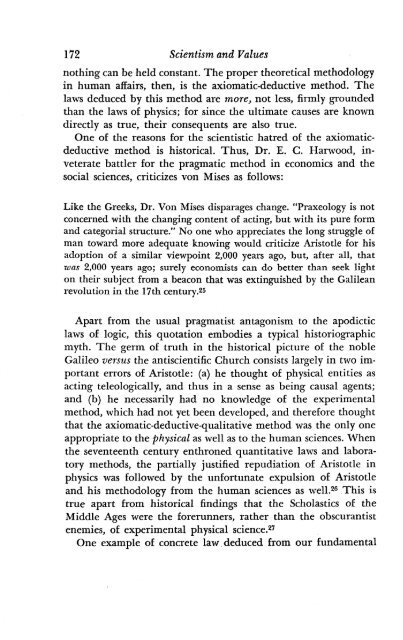Scientism and Values.pdf - Ludwig von Mises Institute
Scientism and Values.pdf - Ludwig von Mises Institute
Scientism and Values.pdf - Ludwig von Mises Institute
You also want an ePaper? Increase the reach of your titles
YUMPU automatically turns print PDFs into web optimized ePapers that Google loves.
172 <strong>Scientism</strong> <strong>and</strong> <strong>Values</strong><br />
nothing can be held constant. The proper theoretical methodology<br />
in human affairs, then, is the axiomatic-deductive method. The<br />
laws deduced by this method are more) not less, firmly grounded<br />
than the laws of physics; for since the ultimate causes are known<br />
directly as true, their consequents are also true.<br />
One of the reasons for the scientistic hatred of the axiomaticdeductive<br />
method is historical. Thus, Dr. E. ·C. Harwood, inveterate<br />
battler for the pragmatic method in economics <strong>and</strong> the<br />
social sciences, criticizes <strong>von</strong> <strong>Mises</strong> as follows:<br />
Like the Greeks, Dr. Von <strong>Mises</strong> disparages change. "Praxeology is not<br />
concerned with the changing content of acting, but with its pure form<br />
<strong>and</strong> categorial structure." No one who appreciates the long struggle of<br />
man toward more adequate knowing would criticize Aristotle for his<br />
adoption of a similar viewpoint 2,000 years ago, but, after all, that<br />
was 2,000 years ago; surely econoD;lists can do better than seek light<br />
on their subject from a beacon that was extinguished by the Galilean<br />
revolution in the 17th century.25<br />
Apart from the usual pragmatist antagonism to the apodictic<br />
laws of logic, this quotation embodies a typical historiographic<br />
myth. The germ of truth in the historical picture of the noble<br />
Galileo versus the antiscientific Church consists largely in two important<br />
errors of Aristotle: (a) he thought of physical entities as<br />
acting teleologically, <strong>and</strong> thus in a sense as being causal agents;<br />
<strong>and</strong> (b) he necessarily had no knowledge of the experimental<br />
method, which had not yet been developed, <strong>and</strong> therefore thought<br />
that the axiomatic-deductive-qualitative method was the only one<br />
appropriate to the physical as well as, to the human sciences. When<br />
the seventeenth century enthroned quantitative laws <strong>and</strong> laboratory<br />
methods, the partially justified repudiation of Aristotle in<br />
physics was followed by the unfortunate expulsion of Aristotle<br />
<strong>and</strong> his methodology from the human sciences as well.26 This is<br />
true apart from historical findings that the Scholastics of the<br />
Middle Ages were the forerunners, rather than the obscurantist<br />
enemies, of experimental physical science. 27<br />
One example of concrete law deduced from our fundamental
















